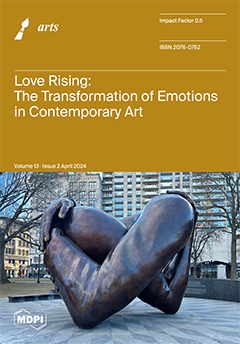In physical environments and cultural landscapes, we most often deal not with separate colors, but with color combinations. When choosing a color, we usually try to “fit” it into a preexisting color context, making the new color combination harmonious. Yet are the “laws”
[...] Read more.
In physical environments and cultural landscapes, we most often deal not with separate colors, but with color combinations. When choosing a color, we usually try to “fit” it into a preexisting color context, making the new color combination harmonious. Yet are the “laws” of color harmony fundamental to our shared cognitive architecture, or are they cultural products that vary from country to country? To answer these questions we conducted an experiment with 599 participants aged 18 to 76 from eight different countries, including Algeria (MA = 26.2 years; SD = 8.8; 49 men, 26 women), Belarus (MA = 19.8 years; SD = 9.1; 19 men, 63 women), Italy (MA = 29.0 years; SD = 12.8; 23 men, 67 women), Mexico (MA = 20.0 years; SD = 7.0; 34 men, 23 women), Nigeria (MA = 34.7 years; SD = 10.5; 29 men, 32 women), Russia (MA = 24.6 years; SD = 6.3; 17 men, 72 women), Saudi Arabia (MA = 24.5 years; SD = 8.6; 28 men, 38 women), and Chile (MA = 34.3 years; SD = 15.1; 35 men, 43 women). To create experimental stimuli, we used 10 color combinations composed by the Russian avant-garde artist Mikhail Matyushin and his disciples for the
Reference Book of Color (1932) based on shades that were typical in architectural design—yellow ochre, light umber, light ochre, and burnt umber. We removed the “intermediary” linking color from each of the selected color triads and asked participants to adjust the color of this band according to their liking. Mapping 2995 color choices into CIELAB and CIELCh color space to identify their chromatic characteristics (hue, lightness, and chroma), we demonstrate graphically that color triads in different cultures have a different “geometry” in CIELAB color space and on the color circle. We conclude that the revealed patterns of these relationships reflect cross-cultural “shifts” in human perception of color harmony. The analysis presented in this paper will facilitate opportunities for architects, designers, and other color professionals to create culturally specific harmonic color combinations in urban environments.
Full article




